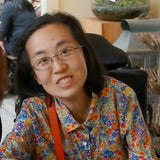Making History: The Disability Visibility Project
History moves along day by day, with headlines and stories around the world capturing attention. But the Disability Visibility Project, in partnership with StoryCorps, is making a permanent mark on history and bringing awareness to the disabled community.
 Alice Wong, project coordinator of the Disability Visibility Project, grew up in the Midwest, and experienced firsthand the challenges of growing up with disabilities. “I was acutely aware of my differences by others, especially in a place where I was almost always the only wheelchair-using student in the classroom,” said Wong. But she didn’t let these obstacles discourage her. Instead, they sparked in her a drive to bring awareness and help others facing the same challenges.
Alice Wong, project coordinator of the Disability Visibility Project, grew up in the Midwest, and experienced firsthand the challenges of growing up with disabilities. “I was acutely aware of my differences by others, especially in a place where I was almost always the only wheelchair-using student in the classroom,” said Wong. But she didn’t let these obstacles discourage her. Instead, they sparked in her a drive to bring awareness and help others facing the same challenges.
Eventually, she attended an event in San Francisco hosted by StoryCorps, an organization that conducts interviews documenting the experiences and stories of people from all walks of life. With locations in Atlanta, Chicago, and San Francisco, and a Mobile Office that travels across the nation, everyone has the chance to record their stories for posterity.
Their mission struck a chord with Wong, and lead to forging the Disability Visibility Project, a combined effort between StoryCorp, Wong, and the disabled community to preserve the experiences of this unrepresented group. Wong pointed out that today, the disabled community is missing a documented history. Society remembers celebrity figures like  Helen Keller, Stevie Wonder, and Marlee Matlin. “But what about the everyday people with disabilities?” asks Wong. This is where StoryCorps and the Disability Visibility Project come in, raising awareness and encouraging those with physical, mental, and/or learning disabilities.
Helen Keller, Stevie Wonder, and Marlee Matlin. “But what about the everyday people with disabilities?” asks Wong. This is where StoryCorps and the Disability Visibility Project come in, raising awareness and encouraging those with physical, mental, and/or learning disabilities.
In a StoryCorps interview, two people who are close to one another—such as family members or friends—meet to talk. A trained facilitator guides them through the 40-minute interview process. At the end of each recording session, participants receive a copy of their interview, and can choose to have a second copy archived at the American Folklife Center in the Library of Congress. Disibility Visibility participants can tag their interview under Disablity Visibility Project, becoming part of a larger archive of powerful stories available to future generations.
“There’s something so powerful about two people coming together sharing their lives,” said Wong. “This is my small part at giving back to the disability community that I’ve been so lucky to be a part of.”
Open LORE is a proud Disability Visibility Project media partner (#77).
For more information, visit disabilityvisibilityproject.com or storycorps.org.
